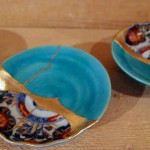Arene bliver hvad de skal udstille
The kintsugi technique may have been invented around the fifteenth century, when Ashikaga Yoshimasa, the eighth shogun of the Ashikaga shogunate after breaking his favourite cup of tea sent it to China to get it repaired. Unfortunately, at that time the objects were repaired with unsightly and impractical metal ligatures. It seemed that the cup was unrepairable but its owner decided to try to have some Japanese craftsmen repair it. They were surprised at the shogun’s steadfastness, so they decided to transform the cup into a jewel by filling its cracks with lacquered resin and powdered gold. The legend seems plausible because the invention of kintsugi is set in a very fruitful era for art in Japan. Under Yoshimasa’s rule the city saw the development of the Higashiyama bunka cultural movement that was heavily influenced by Zen Buddhism and started the tea ceremony (also called Sado or the Way of Tea) and ikebana (also Kado, way of flowers) traditions, the Noh theatre, the Chinese style of painting with ink.
Even today, it may take up to a month to repair the largest and most refined pieces of ceramics with the kintsugi technique, given the different steps and the drying time required.
How many beautiful messages the kintsugi technique conveys
The kintsugi technique suggests many things. We shouldn’t throw away broken objects. When an object breaks, it doesn’t mean that it is no more useful. Its breakages can become valuable. We should try to repair things because sometimes in doing so we obtain more valuable objects. This is the essence of resilience. Each of us should look for a way to cope with traumatic events in a positive way, learn from negative experiences, take the best from them and convince ourselves that exactly these experiences make each person unique, precious.



















